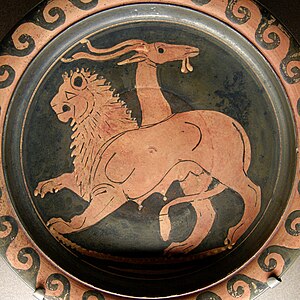Χίμαιρα: Difference between revisions
ἄλογον δὴ τὸ μήτε μάχης ἄρξασθαι μήτε τοὺς φίλους φυλάξαι, ἐὰν ὑπό γε τῶν βαρβάρων ἀδικῆσθε → It is irrational neither to begin battle nor to guard the friends, if you are ever wronged by the foreigners
m (Text replacement - "(==Translations==)(?s)(\n)(.*)($)" to "{{trml |trtx=$3 }} ") |
m (Text replacement - "(?s)(==Wikipedia EN==)(\n)(.*)(\n[{=])" to "{{wkpen |wketx=$3 }}$4") |
||
| Line 1: | Line 1: | ||
= | {{wkpen | ||
[[File:Chimera Apulia Louvre K362.jpg|thumb|The Chimera on a red-figure Apulian plate, c. 350–340 BC (Musée du Louvre)]] | |wketx=[[File:Chimera Apulia Louvre K362.jpg|thumb|The Chimera on a red-figure Apulian plate, c. 350–340 BC (Musée du Louvre)]] | ||
The [[Chimera]] (/kɪˈmɪərə/ or /kaɪˈmɪərə/, also [[Chimaera]] (Chimæra); Greek: [[Χίμαιρα]], Chímaira "[[she-goat]]"), according to Greek mythology, was a monstrous fire-breathing hybrid creature of Lycia in Asia Minor, composed of the parts of more than one animal. It is usually depicted as a lion, with the head of a goat protruding from its back, and a tail that might end with a snake's head. It was one of the offspring of Typhon and Echidna and a sibling of such monsters as Cerberus and the Lernaean Hydra. The term "chimera" has come to describe any mythical or fictional creature with parts taken from various animals, to describe anything composed of very disparate parts, or perceived as wildly imaginative, implausible, or dazzling. | The [[Chimera]] (/kɪˈmɪərə/ or /kaɪˈmɪərə/, also [[Chimaera]] (Chimæra); Greek: [[Χίμαιρα]], Chímaira "[[she-goat]]"), according to Greek mythology, was a monstrous fire-breathing hybrid creature of Lycia in Asia Minor, composed of the parts of more than one animal. It is usually depicted as a lion, with the head of a goat protruding from its back, and a tail that might end with a snake's head. It was one of the offspring of Typhon and Echidna and a sibling of such monsters as Cerberus and the Lernaean Hydra. The term "chimera" has come to describe any mythical or fictional creature with parts taken from various animals, to describe anything composed of very disparate parts, or perceived as wildly imaginative, implausible, or dazzling. | ||
}} | |||
==Wikipedia EL== | ==Wikipedia EL== | ||
Στην Ελληνική μυθολογία αναφέρεται η Χίμαιρα ως ένα φοβερό τέρας, ένα μυθολογικό ζώο,που εξέπνεε φωτιά, είχε σώμα κατσίκας, κεφάλι λιονταριού, και η ουρά του κατέληγε σε φίδι. Σύμφωνα με άλλες περιγραφές, είχε περισσότερα από ένα κεφάλια, συνηθέστερα τρικέφαλος (κεφαλή λέοντα, κατσίκας και δράκοντα). Η Χίμαιρα σύμφωνα με την ιστορία είχε με τον Όρθρο ένα παιδί την Σφίγγα. | Στην Ελληνική μυθολογία αναφέρεται η Χίμαιρα ως ένα φοβερό τέρας, ένα μυθολογικό ζώο,που εξέπνεε φωτιά, είχε σώμα κατσίκας, κεφάλι λιονταριού, και η ουρά του κατέληγε σε φίδι. Σύμφωνα με άλλες περιγραφές, είχε περισσότερα από ένα κεφάλια, συνηθέστερα τρικέφαλος (κεφαλή λέοντα, κατσίκας και δράκοντα). Η Χίμαιρα σύμφωνα με την ιστορία είχε με τον Όρθρο ένα παιδί την Σφίγγα. | ||
Revision as of 11:25, 13 October 2022
Wikipedia EN
The Chimera (/kɪˈmɪərə/ or /kaɪˈmɪərə/, also Chimaera (Chimæra); Greek: Χίμαιρα, Chímaira "she-goat"), according to Greek mythology, was a monstrous fire-breathing hybrid creature of Lycia in Asia Minor, composed of the parts of more than one animal. It is usually depicted as a lion, with the head of a goat protruding from its back, and a tail that might end with a snake's head. It was one of the offspring of Typhon and Echidna and a sibling of such monsters as Cerberus and the Lernaean Hydra. The term "chimera" has come to describe any mythical or fictional creature with parts taken from various animals, to describe anything composed of very disparate parts, or perceived as wildly imaginative, implausible, or dazzling.
Wikipedia EL
Στην Ελληνική μυθολογία αναφέρεται η Χίμαιρα ως ένα φοβερό τέρας, ένα μυθολογικό ζώο,που εξέπνεε φωτιά, είχε σώμα κατσίκας, κεφάλι λιονταριού, και η ουρά του κατέληγε σε φίδι. Σύμφωνα με άλλες περιγραφές, είχε περισσότερα από ένα κεφάλια, συνηθέστερα τρικέφαλος (κεφαλή λέοντα, κατσίκας και δράκοντα). Η Χίμαιρα σύμφωνα με την ιστορία είχε με τον Όρθρο ένα παιδί την Σφίγγα.
French (Bailly abrégé)
ας (ἡ) :
la Chimère, monstre de Lycie soufflant du feu, avec tête de lion, corps de chèvre et queue de serpent.
Étymologie: χίμαιρα.
English (Autenrieth)
the Chimaera, a monster sent as a plague upon Lydia, but slain by Bellerophon, described Il. 6.179-182. (The cut is from an Etruscan bronze figure of large size in the museum at Florence.)
English (Slater)
Χῐμαιρα a monster slain by Bellerophon. Χίμαιραν πῦρ πνέοισαν καὶ Σολύμους ἔπεφνεν (O. 13.90)
Russian (Dvoretsky)
Χίμαιρα: ἡ Химера (баснословное огнедышащее чудовище в Ликии с головой льва, туловищем козы и хвостом дракона - πρόσθε λέων, ὄπιθεν δὲ δράκων, μέσση δὲ χίμαιρα Hom.; τρισώματος ἀλκά Eur.; у Hes. - дочь Тифона и Эхидны, с тремя головами: льва, козы и дракона; убита Беллерофонтом).
Translations
arc: ܟܝܡܪܐ; ar: كمير; az: Ximera; be_x_old: Хімэра; be: Хімера; bg: Химера; bn: খিমাইরা; br: Kimera; bs: Himera; ca: Quimera; co: Chimera; cs: Chiméra; da: Kimære; de: Chimära; el: Χίμαιρα; en: Chimera; eo: Ĥimero; es: Quimera; et: Kimäär; eu: Kimera; fa: شیمر; fi: Khimaira; fr: Chimère; gl: Quimera; he: כימרה; hr: Himera; hu: Khimaira; hy: Քիմեռ; id: Khimaira; it: Chimera; ja: キマイラ; ka: ქიმერა; kn: ಕೈಮೀರ; ko: 키마이라; la: Chimaera; lt: Chimera; lv: Himera; mk: Химера; my: ခစ်မိယားရာ; nl: Chimaera; nn: Kimære; no: Kimære; oc: Quimèra; pl: Chimera; pt: Quimera; ro: Himeră; ru: Химера; sh: Himera; simple: Chimera; sk: Chiméra; sl: Himera; sq: Kimera; sr: Химера; sv: Chimaira; te: కిమేర; th: คิเมียรา; tr: Kimera; uk: Химера; vi: Chimera; war: Chimaera; wuu: 客迈拉; zh: 喀邁拉

